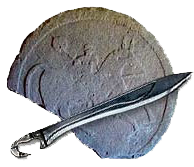Autor: jeromor
miércoles, 09 de mayo de 2007
Sección: Historia Antigua
Información publicada por: jeromor
Mostrado 194.341 veces.
Iruña- Veleia IV
-
Abrimos nuevo capítulo dedicado a opiniones y noticias sobre esta excavación, apasionante y llena de suspense.Es continuación de:
Iruña- Veleia I
Iruña- Veleia desentierra jeroglíficos y grafías en latín de la historia de Egipto (Promovido por J. Rodríguez Morales)
http://www.celtiberia.net/articulo.asp?id=2042
Iruña- Veleia II
COMUNICADO OFICIAL DEL PROYECTO DE INVESTIGACIÓN DE IRUÑA-VELEIA
En torno a los grafitos hallados en las
excavaciones de la ciudad romana de Iruña-Veleia (Promovido por J. Rodríguez Morales)
http://www.celtiberia.net/articulo.asp?id=2364
IRUÑA-VELEIA. Archivo gráfico y temático de los grafitos(Información publicada por A.M.Canto)
http://www.celtiberia.net/articulo.asp?id=2372
Iruña- Veleia III Tres de los 10 arqueólogos de Veleia abandonan por sorpresa las excavaciones.
La dirección del yacimiento alavés atribuye la marcha de los tres expertos a motivos «laborales» (promovido por J. Rodríguez Morales)
http://www.celtiberia.net/articulo.asp?id=2474
-
No hay imágenes relacionadas.
Comentarios
 Pulsa este icono si opinas que la información está fuera de lugar, no tiene rigor o es de nulo interés.
Pulsa este icono si opinas que la información está fuera de lugar, no tiene rigor o es de nulo interés.
Tu único clic no la borarrá, pero contribuirá a que la sabiduría del grupo pueda funcionar correctamente.
Si te registras como usuario, podrás añadir comentarios a este artículo.

Veleia parece ser una de las variantes antiguas, según dicen J. Santos, A. Emborujo y E. Ortiz de Urbina en un artículo sobre la paelogeografía de los autrigones, caristios y vardulos (en Complutum 2/3; existe acceso directo a versión en pdf: http://www.ucm.es/BUCM/revistas/ghi/11316993/articulos/CMPL9292120449A.PDF)
Parece que hay una mención al étnico (velienses), una la ciudad en PTOLOMEO (Ouélia / Ouéleia) y en el Itinerario de Antonino (Beleia). Quizá se haya adoptado la forma Veleia como forma más estandartizada por la homóloga de Italia.
Lo curioso es que la los hablantes vascófonos se esforzaran tan bien en pronunciar la /w/ y en escribirla adecuadamente V, cuando los demás (ahí está el itinerario) no tenían empacho en pronunciarla con B. E s otro ejemplo de comportamiento contradictorio, de lo que ya hablé hace tiempo.
Aunia, por si vale de algo
Draft Version of a Dictionary of Continental Celtic Place-Names (unpublished) Falileyev, Alexander
http://cadair.aber.ac.uk/dspace/bitstream/2160/282/6/LETTER+B.pdf
Bele(g)ia
Hay 2 comentarios.
1